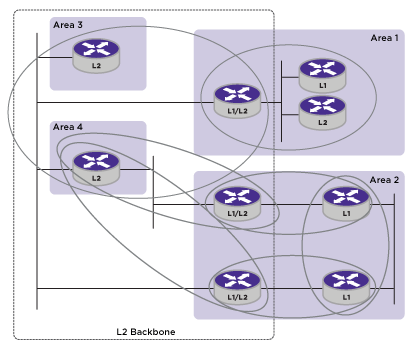IS-IS has a two-level hierarchy. IS-IS routers may participate in either level or both. Basic Autonomous System shows a basic IS-IS AS.

In the network in the above figure, each of the ellipses represents an adjacency. Level 1 (L1) routers within an area need only know the topology within that area as well as the location of the nearest L1/L2 attached router. An attached router is one that participates in both levels and can reach at least one other L1/L2 or L2 router with a different area address.
In an AS, there is only one L2 area, and it serves as a backbone area between L1 areas. This L2 area is also called a domain (not to be confused with the entire AS routing domain). L2 routers communicate with one another irrespective of L1 area membership or L2 area address.

Note
On any switch, the maximum number of L1/L2 adjacencies is one half the maximum number of L1 or L2 adjacencies because an L1/L2 adjacency defines both an L1 adjacency and an L2 adjacency. The supported adjacency limits are defined in the ExtremeXOS Release Notes.For information on creating and managing IS-IS areas, see Managing an IS-IS Area Address.

 Print
this page
Print
this page Email this topic
Email this topic Feedback
Feedback